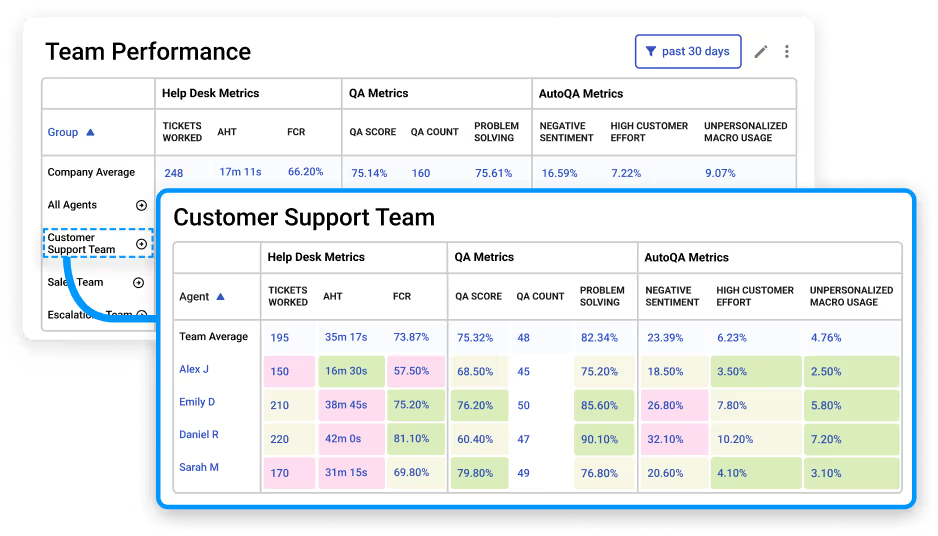Unlocking the Power of Sentiment Analysis
Sentiment Analysis in CX and QA
With team calibration, contact center managers can evaluate agent performance individually using the same quality scorecard, then convene for a live Calibration Session to align on evaluation standards and criteria, address discrepancies, and provide actionable feedback for improvement. Establishing a regular calibration cadence promotes consistency in grading practices and helps ensure trustworthy QA data.
Chapter 1: Understanding Sentiment Analysis
What is Sentiment Analysis?
At its core, sentiment analysis involves using natural language processing (NLP) to identify and categorize emotions expressed in customer communications. This can range from identifying positive sentiments in a customer’s praise to detecting dissatisfaction in a complaint.
Why Sentiment Analysis Matters
Sentiment analysis goes beyond traditional metrics like CSAT (Customer Satisfaction) scores, offering insights into every customer interaction, not just the ones where customers explicitly provide feedback. This allows businesses to tap into a more comprehensive understanding of customer sentiment, driving more informed decisions.
Chapter 2: The Pros and Cons of Sentiment Analysis
To harness the true value of Sentiment Analysis it’s essential to navigate the pros and cons, and adopt best practices tailored to your unique business goals.
The Advantages
Actionable Insights
Sentiment analysis provides a deeper understanding of customer emotions, enabling businesses to tailor their approaches to meet customer needs more effectively.
Scalability & Efficiency
Unlike traditional QA methods, sentiment analysis can process vast amounts of data quickly, making it easier to manage and analyze customer interactions at scale.
Reliable Decision-Making
By leveraging sentiment analysis, teams can base their strategies on comprehensive, data-backed insights, leading to more effective and targeted actions.
Boosting Agent Performance
By identifying areas for improvement, sentiment analysis enables more focused coaching for agents, helping them meet and exceed customer expectations.
The Challenges
Domain-Specific Effectiveness
Sentiment analysis requires customization to accurately reflect the nuances of your specific industry and customer interactions.
Limited Applicability
Not all customer interactions are suitable for sentiment analysis, necessitating careful consideration of when and where to deploy this tool.
Mitigating Biases & Limitations
Third-party technologies used in sentiment analysis can introduce biases, requiring continuous monitoring to maintain accuracy and fairness.
Interpretation Challenges
The complexity of machine learning models can create difficulties in gaining internal buy-in, as the reasoning behind sentiment scores may not always be clear.
Chapter 3: Best Practices for Effective Sentiment Analysis

Key Takeaways for Successful Sentiment Analysis Implementation
Define Clear Objectives
Before implementing sentiment analysis, align it with your business goals. Whether you aim to improve customer satisfaction, boost agent performance, or gain deeper insights into customer sentiment, having clear objectives ensures your efforts are purpose-driven.
Choose the Right Tool
Selecting a sentiment analysis tool that is accurate, scalable, and cost-effective is critical. Evaluate available options thoroughly to ensure the chosen solution meets your business’s unique needs.
Customize for Your Business
Tailor sentiment analysis to your specific industry and customer interactions. This customization is key to ensuring that the analysis accurately captures the nuances of your customer’s emotions.
Continuously Evaluate and Refine
Sentiment analysis is not a set-it-and-forget-it tool. Regularly assess and update your sentiment models to ensure they remain relevant and effective as customer sentiment evolves.
Chapter 4: Practical Applications and Use Cases
Implementing Sentiment Analysis in QA Programs
Many organizations see sentiment analysis as a way to complement or even replace traditional QA methods. It allows for the analysis of 100% of customer interactions, providing a broader view of performance and customer satisfaction.
Use Cases:
Positive vs. Negative Sentiment Tracking
Whether you're tracking positive or negative sentiment, it's important to consider the specific use case. For example, are you focusing on customer sentiment, agent sentiment, or both? Are you analyzing sentiment across different channels like email, chat, or phone?
Escalation Management
Real-time sentiment analysis can help detect when a customer interaction is escalating negatively, allowing for proactive management before the situation worsens.
Agent Performance Monitoring
Use sentiment scores as a KPI to measure agent performance. However, it's essential to ensure that these scores are complemented by other performance metrics to avoid over-reliance on machine learning models.
Chapter 5: Looking Forward—The Future of Sentiment Analysis
As the technology behind sentiment analysis continues to evolve, businesses must stay ahead by adapting their strategies and tools. The integration of open-source technologies, for example, offers a cost-effective alternative that may provide better results. However, the key to successful sentiment analysis will always be its alignment with your business goals and continuous refinement to meet the changing needs of your customers.
Webinar
Pros & Cons of Sentiment Webinar
By understanding customer sentiment and utilizing sentiment analysis effectively, organizations can unlock deep insights, improve agent performance, and foster long-lasting customer relationships. Listen to our discussion on-demand now.
















































